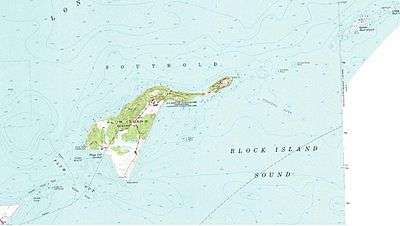Great Gull Island

Great Gull Island is a 17-acre (6.9 ha) island separating Long Island and Block Island sounds, located approximately 0.4 miles (0.6 km) southwest of Little Gull Island. Both islands are located in Suffolk County, New York, and lie roughly midway between Plum Island and Fishers Island.
History
A major stopover for birds following the Atlantic Flyway, Great Gull Island was the home of large colonies of nesting terns up until the end of the 19th century, when many birds were killed as a result of the millinery trade and the construction of military fortifications on the island. In 1897, Fort Michie was constructed on Great Gull Island to guard the entrance to Long Island Sound. The military base was operational from the Spanish–American War through World War II.[1] It included one of the largest gun installations in the United States, an emplacement for a 16-inch gun on a disappearing carriage.[2]
Great Gull Island was acquired by the American Museum of Natural History on March 31, 1949.[3] It marked the beginning of the Great Gull Island Project, a long-term effort by staff from the museum and other volunteers to restore the island's ecosystem. Gradually, terns began returning to the island to nest, and the population grew into one of the largest colonies in the world for two species of terns.[4][5]
Terns
The dominant faunal feature of the island during the summer months is the active Common Tern (Sterna hirundo) colony spread across the flatter areas of the island that are not taken over by bittersweet (Celastrus) or common reed (Phragmites australis). A tentative estimation of the S. hirundo mating pairs present on the island places their number at 10,000, though this has not been confirmed, due to the inavailability of a complete and authoritative census.
The other major avian on Great Gull Island is the Roseate Tern (Sterna dougallii), which mostly inhabit the ring of boulders that cover the edges of the island. Originally, these boulders were arranged to prevent erosion and were placed there by the US Army. However, the Roseates are well suited to the narrow crevices and hard-to-reach spaces created in this environment, with their young quite adept at vanishing in between the rocks, only becoming accessible when a parent calls to summon them. The population of S. douglii populating the island is estimated to hover somewhere around 1,000 mating pairs, though no complete census is available.
Personnel
The founder and director of the program is Helen Hays, who has been managing the island since 1969. Joe DiCostanzo is responsible for running the database detailing the family history, hatching records, locations of nests and DOB of many of the birds born on or visiting the island.
The Great Gull Island Program has an ongoing partnership with several Argentine projects that monitor the terns during the winter and spring months. Occasionally, as a show of support, an Argentine delegation will arrive to assist in preparation work for "peak week", when hatchings-per-day can range into the thousands. In recognition of their contribution, the west end of the island is thus named "Little Argentina".
References
- ↑ Fox, Margalit (November 14, 2005). "Catherine M. Pessino, Naturalist and Educator, Dies at 80". The New York Times. Retrieved 2009-09-05.
- ↑ Fort Michie at FortWiki.com
- ↑ "Natural History Museum Wins Isle; Great Gull to Become Game Refuge". The New York Times. April 1, 1949. Retrieved 2009-09-05.
- ↑ Ginzburg, Ralph (July 24, 1994). "Rare Terns Flourishing On Tiny Isle". The New York Times. Retrieved 2009-09-05.
- ↑ Laux, E. Vernon (August 21, 2001). "Tiny Island Offers View Into Lives of Rare Birds". The New York Times. Retrieved 2009-09-05.
External links
| Wikimedia Commons has media related to Great Gull Island. |
Coordinates: 41°12′07″N 72°07′09″W / 41.20194°N 72.11917°W